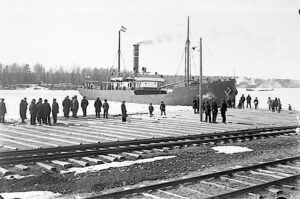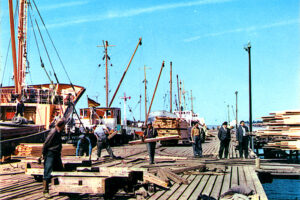History of Kaskinen port
-port of kaskinen
The maritime history of Kaskinen dates back to the 1770s when a small warehouse, customs house, and pier were established at what is now known as the Inner Harbor.
 The city of Kaskinen originated in 1785 when King Gustav III of Sweden granted special privileges to the city by signing a charter. The maritime history of Kaskinen dates back to the 1770s when a small warehouse, customs house, and pier were established at what is now known as the Inner Harbor. Initially, maritime traffic was modest, but over time, merchants and the city itself built more piers, such as the Customs Pier, which operated at the current location of the guest harbor. Although maritime traffic and port activities only intensified in 1875, Kaskinen Port was already known in the medieval period for its deep and sheltered waterways.
The city of Kaskinen originated in 1785 when King Gustav III of Sweden granted special privileges to the city by signing a charter. The maritime history of Kaskinen dates back to the 1770s when a small warehouse, customs house, and pier were established at what is now known as the Inner Harbor. Initially, maritime traffic was modest, but over time, merchants and the city itself built more piers, such as the Customs Pier, which operated at the current location of the guest harbor. Although maritime traffic and port activities only intensified in 1875, Kaskinen Port was already known in the medieval period for its deep and sheltered waterways.
 In 1912, the railway arrived in Kaskinen, and a railway was laid to the Inner Harbor. Around the same time, the Pile Pier was introduced, located at the present site of the Outer Port, which was started to be built in 1955. The Deep Port was started to be built in 1977, and which has now expanded to 900 meters and offers eight berth places. Deep port is the second newest port in Finland after Vuosaari port.
In 1912, the railway arrived in Kaskinen, and a railway was laid to the Inner Harbor. Around the same time, the Pile Pier was introduced, located at the present site of the Outer Port, which was started to be built in 1955. The Deep Port was started to be built in 1977, and which has now expanded to 900 meters and offers eight berth places. Deep port is the second newest port in Finland after Vuosaari port.
The development of the port was significantly influenced by the growth of the timber processing industry in the 19th century, especially by the construction of the Metsä-Botnia factory in Kaskinen in 1977. The importance of the port was also strengthened by the concentration of Finnforest’s Finnish sawmills shipments to Kaskinen in the 1990s and M-Real’s factory investment in the 2000s (current MetsäBoard).
 Once, the most important export products were tar, pitch, sawn and carved timber, and agricultural products. Salt was also a significant import commodity. Nowadays, the main export articles are wind turbine components, sawn timber, pulp, and thermomechanical pulp. Additionally chemicals, feed and fertilizers as well as growing peat are shipped to some extent.
Once, the most important export products were tar, pitch, sawn and carved timber, and agricultural products. Salt was also a significant import commodity. Nowadays, the main export articles are wind turbine components, sawn timber, pulp, and thermomechanical pulp. Additionally chemicals, feed and fertilizers as well as growing peat are shipped to some extent.
Since 1934, Kaskinen Port has served as an important winter port for the pulp industry in Northern Finland, but this role changed in 1974 when Finland’s new icebreakers began to keep routes open to northern ports.
 In the early stages of port operations, loading and unloading of ships were the responsibility of the ship’s crew. In the early 20th century, specialized stevedores began to take care of this task. Initially, cargo handling was entirely manual, but with the spread of steamships in the 1870s, the first winches were introduced. About 100 years later, land-based lifting equipment arrived, marking significant progress in cargo handling. Initially, port workers in Kaskinen were employed on a temporary basis, but in 1983, Kaskö Stevedoring made crane operators permanent, and in 2001, other stevedores. Before World War II, there could be up to 200 workers in the port during the busiest times, whereas nowadays, the traffic volume is about fifteen times higher, and the port employs regularly 50–60 workers.
In the early stages of port operations, loading and unloading of ships were the responsibility of the ship’s crew. In the early 20th century, specialized stevedores began to take care of this task. Initially, cargo handling was entirely manual, but with the spread of steamships in the 1870s, the first winches were introduced. About 100 years later, land-based lifting equipment arrived, marking significant progress in cargo handling. Initially, port workers in Kaskinen were employed on a temporary basis, but in 1983, Kaskö Stevedoring made crane operators permanent, and in 2001, other stevedores. Before World War II, there could be up to 200 workers in the port during the busiest times, whereas nowadays, the traffic volume is about fifteen times higher, and the port employs regularly 50–60 workers.
Transformation into a Modern Digitalized Freight Port
By 2016, the Port of Kaskinen had successfully recovered from the ongoing restructuring in the forest industry. The recession that began in 2008 had an impact on maritime transport, but even then, Kaskinen managed to weather the storm, and significant plans were made to develop the port and expand the port area.
In 2017, Patrik Hellman was appointed as the CEO of Port of Kaskinen Ltd., tasked with focusing on marketing and development to expand the port’s operations. Strategic growth directions were defined during the years 2018-2024, and a new growth plan was formulated, including flagship projects and analysis of customer needs.
In 2020, there was a determined effort towards renewal, leading to the third consecutive year of cargo volume growth and a 25 % increase over three years. In 2021, the port’s traffic volumes continued to grow, and the ongoing digitalization project promoted efficiency and speed. The modernization and digitalization of the port have been key elements in its growth.
The Port of Kaskinen has responded to emission reduction needs, especially with the implementation of the sulfur directive. The port aims to be Finland’s greenest port, requiring increasingly low-emission operations. Overall, the Port of Kaskinen has undergone significant development towards becoming a modern, digitalized freight port.
Looking to the Future
Despite all its achievements, the Port of Kaskinen is not merely observing developments from the sidelines but is heavily investing in the future. For example, the offshore wind farms under construction in the area will generate freight traffic for the port, as the Port of Kaskinen specializes in handling large wind power components. Another project that enhances the attractiveness of the port and the entire area is the possible electrification of the Suupohja railway. The future looks bright, and the history of the Port of Kaskinen continues in the spirit of favorable winds.
